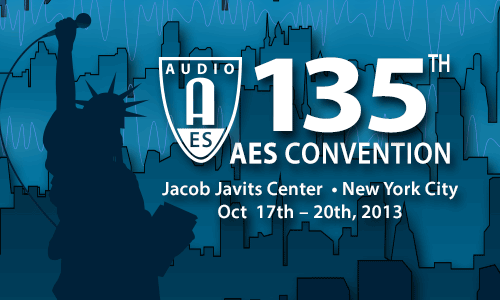
AES New York 2013
Paper Session P18
Sunday, October 20, 2:00 pm — 4:00 pm (Room 1E07)
Paper Session: P18 - Perception—Part 2
Chair:
Agnieszka Roginska, New York University - New York, NY, USA
P18-1 Negative Formant Space, “O Superman,” and Meaning—S. Alexander Reed, Ithaca College - New York, NY, USA
This in-progress exploration considers both some relationships between sounding and silent formants in music and the compositional idea of spectral aggregates. Using poststructuralist lenses and also interpretive spectrographic techniques informed by music theorist Robert Cogan, it offers a reading of Laurie Anderson’s 1982 hit “O
Superman” that connects the aforementioned concerns of timbre with interpretive processes of musical meaning. In doing so, it contributes to the expanding musicological considerations of timbre beyond its physical, psychoacoustic, and orchestrational aspects.
Convention Paper 9014 (Purchase now)
P18-2 The Effects of Interaural Level Differences Caused by Interference between Lead and Lag on Summing Localization—M. Torben Pastore, Rensselaer Polytechnic Institute - Troy, NY, USA; Jonas Braasch, Rensselaer Polytechnic Institute - Troy, NY, USA
Traditionally, the perception of an auditory event in the summing localization range is shown as a linear progression from a location between a coherent lead and lag to the lead location as the delay between them increases from 0-ms to approximately 1-ms. This experiment tested the effects of interference between temporally overlapping lead and lag stimuli on summing localization. We found that the perceived lateralization of the auditory event oscillates with the period of the center frequency of the stimulus, unlike what the traditional linear model would predict. Analysis shows that this is caused by interaural level differences due to interference between a coherent lead and lag.
Convention Paper 9015 (Purchase now)
P18-3 Paired Comparison as a Method for Measuring Emotions—Judith Liebetrau, Ilmenau University of Technology - Ilmenau, Germany; Fraunhofer Institute for Digital Media Technology IDMT - Ilmenau, Germany; Johannes Nowak, Ilmenau University of Technology - Ilmenau, Germany; Fraunhofer Institute for Digital Media Technology IDMT - Ilmenau, Germany; Thomas Sporer, Fraunhofer Institute for Digital Media Technology IDMT - Ilmenau, Germany; Ilmenau University of Technology - Ilmenau, Germany; Matthias Krause, Ilmenau University of Technology - Ilmenau, Germany; Martin Rekitt, Ilmenau University of Technology - Ilmenau, Germany; Sebastian Schneider, Ilmenau University of Technology - Ilmenau, Germany
Due to the growing complexity and functionality of multimedia systems, quality evaluation becomes a cross-disciplinary task, taking technology-centric assessment, as well as human factors into account. Undoubtedly, emotions induced during perception, have a reasonably high influence on the experienced quality. Therefore the assessment of users’ affective state is of great interest for development and improvement of multimedia systems. In this work problems of common assessment methods as well as newly applied methods in emotional research will be displayed. Direct comparison of stimuli as a method intended for faster and easier assessment of emotions is investigated and compared to previous work. The results of the investigation showed that paired comparison seems inadequate to assess multidimensional items/problems, which often occur in multi-media applications.
Convention Paper 9016 (Purchase now)
P18-4 Media Content Emphasis Using Audio Effect Contrasts: Building Quantitative Models from Subjective Evaluations—Xuchen Yang, University of Rochester - Rochester, NY, USA; Zhe Wen, University of Rochester - Rochester, NY, USA; Gang Ren, University of Rochester - Rochester, NY, USA; Mark F. Bocko, University of Rochester - Rochester, NY, USA
In this paper we study media content emphasis patterns of audio effects and construct their quantitative models using subjective evaluation experiments. The media content emphasis patterns are produced by contrasts between effect-sections and non-effect sections, which change the focus of audience attention. We investigate media emphasis patterns of typical audio effects including equalization, reverberation, dynamic range control, and chorus. We compile audio test samples by applying different settings of audio effects and their permutations. Then we construct quantitative models based on the audience rating of the “subjective significance” of test audio segments. Statistical experiment design and analysis techniques are employed to establish the statistical significance of our proposed models.
Convention Paper 9017 (Purchase now)
